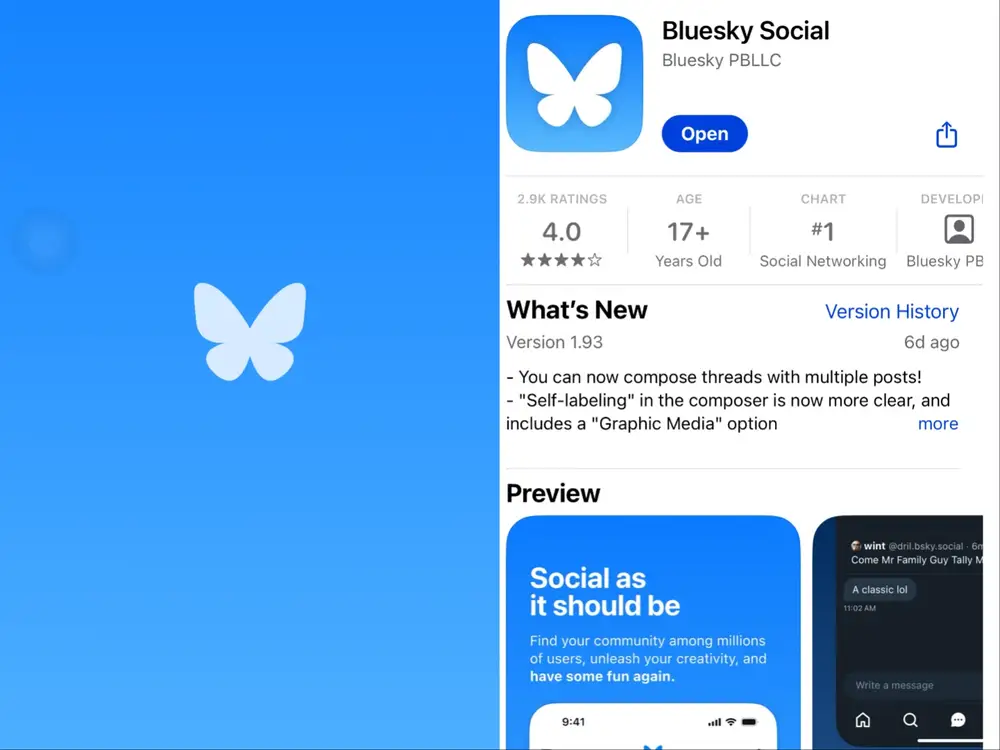In a post-Elon Musk world of social media, users are flocking to alternatives like never before. Among the rising stars of this migration is Bluesky, a platform that promises a blue-sky approach to decentralization and user control. With its Twitter-like interface and unique features, Bluesky has captured the attention of millions, quickly becoming a serious contender in the crowded social media landscape. But what makes Bluesky special, and why are so many people signing up? Let’s dive into everything you need to know about this intriguing X competitor.
Bluesky’s Meteoric Rise: Why Now?
Bluesky’s open-access launch in February 2024 marked a pivotal moment. After almost a year as an invite-only platform, the floodgates opened, welcoming nearly 800,000 new users in a single day. By November 2024, the platform boasted over 16 million users, a number spurred by controversial policy changes on X, including the overhaul of its block feature and concerns over AI companies training on user data.
The app gained additional momentum following the 2024 U.S. presidential election, which also brought Taylor Swift fans en masse to the platform. Yet, despite Bluesky’s impressive growth, it still faces stiff competition from Meta’s Threads, which currently boasts 275 million monthly active users.
What is Bluesky?
Bluesky is a decentralized social app originally conceptualized by former Twitter CEO Jack Dorsey. Unlike traditional platforms, Bluesky emphasizes user autonomy with its open-source AT Protocol, allowing for transparency and community-driven development.
Here’s what sets it apart:
- Twitter-Like Experience: Bluesky offers a familiar interface featuring posts, replies, likes, and retweets.
- Algorithmic Choice: Users can select from custom algorithms to tailor their experience.
- Federated Design: Bluesky is building toward a system where independently operated communities coexist on a shared network.
Bluesky began as a side project under Dorsey in 2019 while he was still at Twitter. However, following Musk’s acquisition of Twitter, Bluesky charted its own course, becoming an independent public benefit corporation under the leadership of CEO Jay Graber in 2021.

How Does Bluesky Work?
Bluesky is simple to use yet offers unique customization options:
- Creating Your Handle: Users choose a handle like
@username.bsky.socialbut can also connect a custom domain to their profile, offering a personal touch. - Posting: Posts are limited to 256 characters and can include photos. Interaction options include replies, likes, reposts, and sharing.
- Timelines: The platform offers both a Home timeline, filled with updates from followed accounts, and a Discover feed, featuring trending and algorithmically curated content.
For new users, the Starter Pack provides a curated list of accounts and custom feeds to jumpstart their experience. Profiles feature familiar elements like a bio, profile picture, and follower metrics, making the transition from X or Threads seamless.
Who’s on Bluesky?
Bluesky’s user base includes high-profile personalities and organizations. Early adopters include Rep. Alexandria Ocasio-Cortez, Mark Cuban, Weird Al Yankovic, Dril, and even Brazilian President Luiz Inácio Lula da Silva. News outlets like Bloomberg and The Washington Post also use the platform.
Since August 2024, Bluesky has allowed heads of state to join, further cementing its position as a legitimate competitor to X in the political and media spheres.
Key Features That Set Bluesky Apart
Bluesky combines familiar social media features with innovative solutions to modern challenges.
1. Decentralization at Its Core
Bluesky’s AT Protocol enables decentralization, meaning users are not tied to a single app or platform. This model allows for:
- Portability: Users can move their data, followers, and handle across apps built on the protocol.
- User Freedom: You’re no longer at the mercy of private companies’ algorithms or decisions.
2. Custom Feeds
Launched in May 2023, custom feeds let users curate their timeline based on specific interests. These feeds can be pinned for quick access, making it easier to toggle between curated content. Developers can even build and share their own feeds.
3. Enhanced Moderation Tools
Moderation has been a focus area for Bluesky:
- Advanced automation flags content violating guidelines.
- Features like user and moderation lists help block or mute accounts at scale.
- Ozone, a new tool, allows users to run their own independent moderation services.
Upcoming features, including private accounts and reply-limiting options, aim to address user concerns about safety and privacy.
Bluesky vs. X: What’s Different?
While Bluesky may feel like a lighter, decentralized version of X, there are significant differences:
- Block Feature: Bluesky retains a traditional block option, unlike X’s controversial update, which allows blocked users to view posts.
- Decentralization: Unlike X, Bluesky is built on a transparent, open-source protocol.
- No Ads: Bluesky aims to sustain its network through paid services, not advertising, keeping it free from invasive data collection.
How Does Bluesky Monetize?
To avoid reliance on advertising, Bluesky has explored innovative monetization strategies:
- Custom Domains: Users can purchase personalized domains as their handles.
- Premium Features: A subscription service, announced in November 2024, will include benefits like higher-quality video uploads and advanced profile customization.
This approach ensures Bluesky remains free for general users while maintaining a sustainable revenue model.
Addressing Challenges: Security, Moderation, and Growth
Bluesky is actively working to overcome its early hurdles:
- Security Enhancements: Email verification and account authentication tools have been added to bolster user safety.
- Moderation Controversies: Early criticism of lax moderation prompted Bluesky to introduce stricter tools and guidelines, including safeguards against slurs and offensive terms.
- Growing Pains: Despite rapid growth, Bluesky must contend with challenges like scaling its decentralized infrastructure and catching up to competitors like Threads.
The Road Ahead for Bluesky
Bluesky is still evolving, but its emphasis on decentralization, transparency, and user autonomy gives it a unique edge. As it continues to innovate with custom feeds, federated networks, and user-focused tools, it’s clear that the platform is more than just a Twitter clone — it’s a reimagining of what social media can be.
Whether you’re seeking a Twitter alternative, a more private platform, or a customizable user experience, Bluesky offers a fresh perspective in a world dominated by corporate-controlled platforms.
As the saying goes, the sky’s the limit. And for Bluesky, that might just be true.










